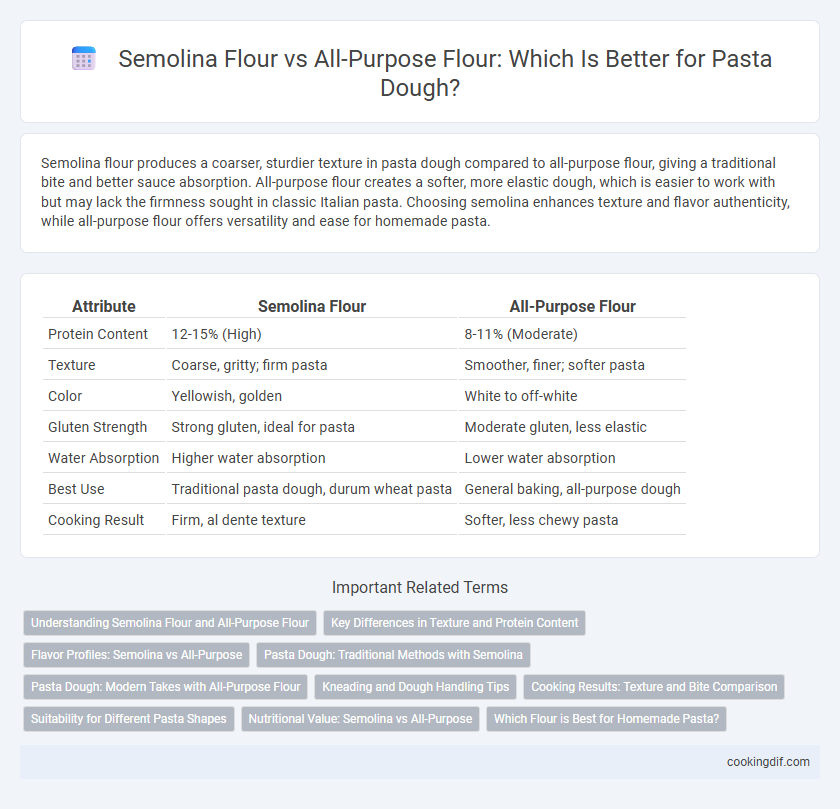Semolina flour produces a coarser, sturdier texture in pasta dough compared to all-purpose flour, giving a traditional bite and better sauce absorption. All-purpose flour creates a softer, more elastic dough, which is easier to work with but may lack the firmness sought in classic Italian pasta. Choosing semolina enhances texture and flavor authenticity, while all-purpose flour offers versatility and ease for homemade pasta.
Table of Comparison
| Attribute | Semolina Flour | All-Purpose Flour |
|---|---|---|
| Protein Content | 12-15% (High) | 8-11% (Moderate) |
| Texture | Coarse, gritty; firm pasta | Smoother, finer; softer pasta |
| Color | Yellowish, golden | White to off-white |
| Gluten Strength | Strong gluten, ideal for pasta | Moderate gluten, less elastic |
| Water Absorption | Higher water absorption | Lower water absorption |
| Best Use | Traditional pasta dough, durum wheat pasta | General baking, all-purpose dough |
| Cooking Result | Firm, al dente texture | Softer, less chewy pasta |
Understanding Semolina Flour and All-Purpose Flour
Semolina flour, made from durum wheat, offers a coarser texture and higher protein content, ideal for pasta dough that requires firmness and a slightly grainy bite. All-purpose flour, derived from a blend of hard and soft wheat, provides a finer texture with moderate gluten strength, resulting in softer and more pliable dough suitable for versatile pasta types. Understanding these flour characteristics helps tailor pasta dough consistency, texture, and cooking performance.
Key Differences in Texture and Protein Content
Semolina flour, derived from durum wheat, contains higher protein content (approximately 12-15%) compared to all-purpose flour's 8-11%, resulting in a denser, firmer pasta dough with a slightly coarse texture. All-purpose flour produces a softer, more elastic dough due to its moderate gluten strength and finer grind, making it suitable for tender pasta varieties. The protein content and granularity of semolina enhance pasta's al dente bite and durability during boiling, which is less pronounced in all-purpose flour dough.
Flavor Profiles: Semolina vs All-Purpose
Semolina flour imparts a nutty, slightly sweet flavor to pasta dough, enhancing its rich, earthy taste compared to the neutral profile of all-purpose flour. The coarser texture of semolina contributes to a more robust mouthfeel and a subtly toasted aroma when cooked. All-purpose flour, with its finer grind, produces a milder taste that allows sauces and seasonings to dominate the pasta's flavor profile.
Pasta Dough: Traditional Methods with Semolina
Semolina flour, derived from durum wheat, offers higher protein and gluten content than all-purpose flour, resulting in pasta dough with superior elasticity and a firm texture ideal for traditional pasta shapes. This coarse, granular flour absorbs water effectively, producing dough that withstands boiling without becoming mushy, a crucial factor in authentic Italian pasta-making. In contrast, all-purpose flour yields a softer, less resilient dough, often preferred for delicate pastries but less suited for the robust structure required in classic semolina-based pasta.
Pasta Dough: Modern Takes with All-Purpose Flour
Semolina flour, derived from durum wheat, offers a coarse texture and high gluten content, making it ideal for traditional pasta with a firm bite. Modern pasta doughs frequently incorporate all-purpose flour, which provides a finer texture and more elasticity, suitable for softer, more delicate pasta shapes. Combining semolina and all-purpose flour balances chewiness and tenderness, enabling versatile pasta dough textures favored in contemporary recipes.
Kneading and Dough Handling Tips
Semolina flour's coarser texture and higher protein content create a firmer dough ideal for pasta that holds shape well during kneading. All-purpose flour, being finer and lower in protein, produces a softer, more elastic dough that requires gentle handling to avoid stickiness and overworking. For optimal results, knead semolina dough with firm pressure and rest adequately, while all-purpose dough benefits from shorter kneading times and occasional dusting with flour to maintain manageable consistency.
Cooking Results: Texture and Bite Comparison
Semolina flour, derived from durum wheat, imparts a coarser texture and firmer bite to pasta dough, resulting in a chewier, al dente finish favored in traditional Italian pasta. All-purpose flour, with its lower protein content, creates a softer, more tender dough that yields a less resilient texture after cooking. The granular nature of semolina also enhances sauce adherence, while all-purpose flour produces a smoother surface on the pasta strands.
Suitability for Different Pasta Shapes
Semolina flour's coarse texture and high protein content create a firm, durable dough ideal for shaping robust pasta like rigatoni, penne, and orecchiette, which hold their form during cooking. All-purpose flour produces a softer, more elastic dough better suited for delicate pasta shapes such as fettuccine, tagliatelle, and ravioli that require pliability and ease of rolling. Choosing semolina or all-purpose flour directly impacts pasta texture, cooking performance, and the final dish's mouthfeel.
Nutritional Value: Semolina vs All-Purpose
Semolina flour offers higher protein and gluten content compared to all-purpose flour, resulting in a firmer pasta texture and better cooking resilience. It contains more essential minerals like iron, magnesium, and zinc, contributing to improved nutritional value. All-purpose flour, while versatile and lighter in texture, provides fewer nutrients and less protein, making semolina a preferred choice for nutrient-dense pasta dough.
Which Flour is Best for Homemade Pasta?
Semolina flour, derived from durum wheat, offers a high protein content and coarse texture that enhances pasta's firmness and bite, making it ideal for traditional Italian pasta dough. All-purpose flour, with its moderate protein level and fine texture, yields a softer and more pliable dough, suitable for delicate pasta shapes or eggs-based recipes. For authentic, al dente homemade pasta, semolina flour remains the preferred choice due to its superior gluten strength and ability to maintain shape during cooking.
Semolina flour vs all-purpose flour for dough Infographic

 cookingdif.com
cookingdif.com